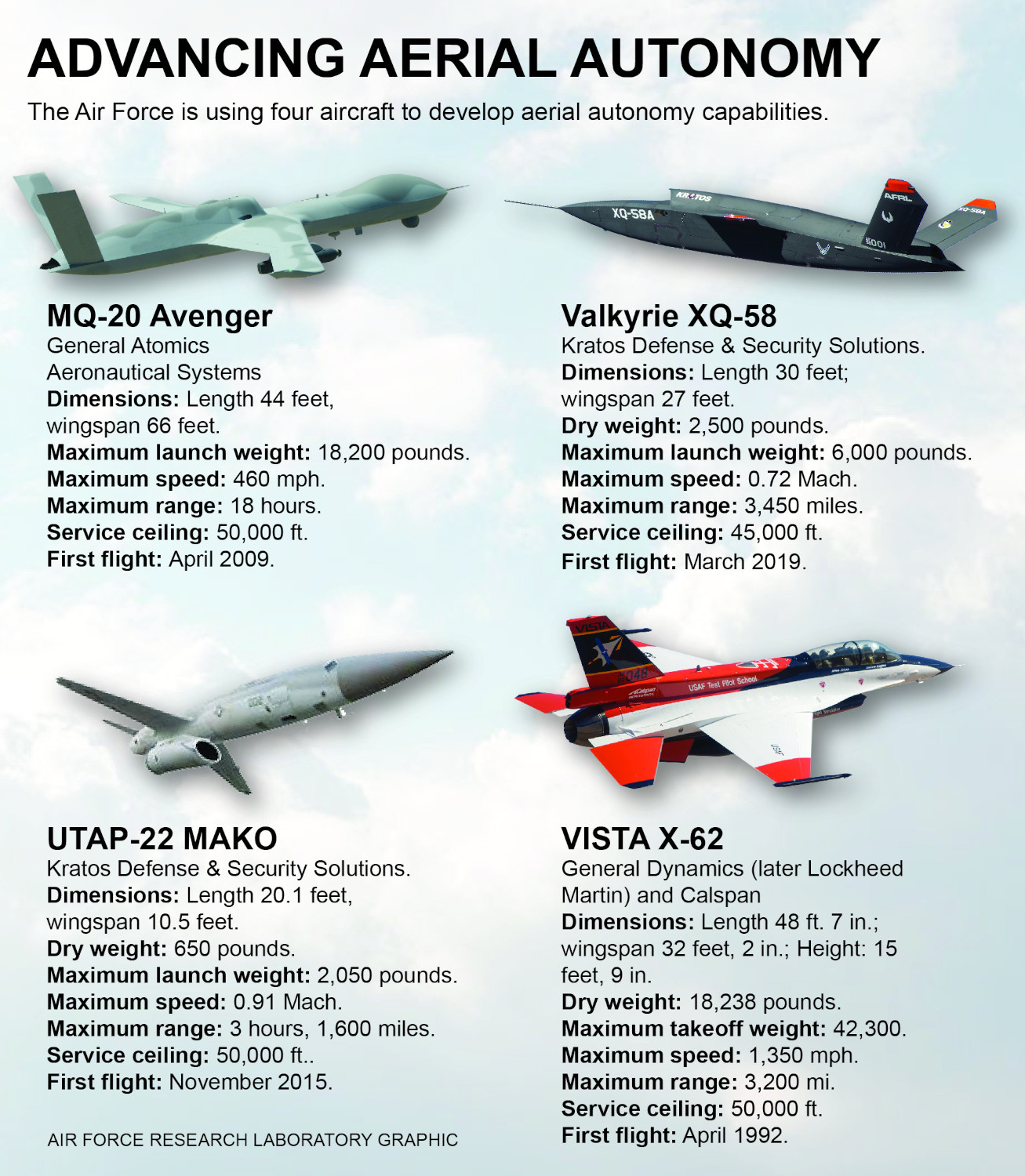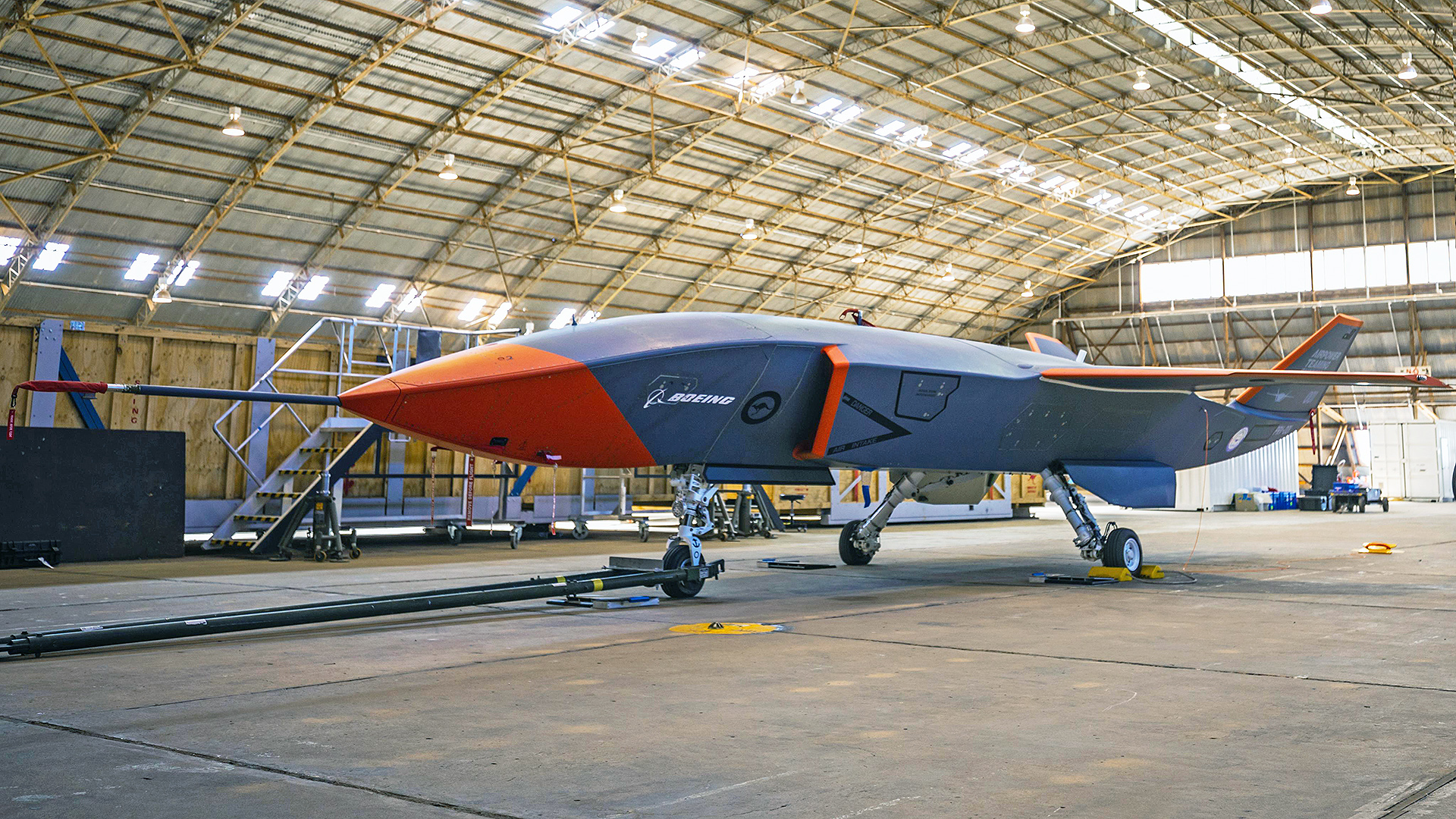Boeing is no longer participating in the Skyborg, which is centered on developing a suite of artificial intelligence-driven systems designed to fly various future autonomous unmanned aircraft, according to the U.S. Air Force. However, the company is still conducting work related to the MQ-28 Ghost Bat, one of which is now in the United States, with an eye toward pitching it to the service as part of future advanced drone initiatives. This all comes as the Air Force is looking to field the first examples of what it expects to be a family of unmanned aircraft with varying capabilities and degrees of autonomy, which will at least initially be designed to work closely with manned aircraft, by the mid-to-late 2020s.
Air Force Brig. Gen. Dale R. White, the Program Executive Officer for Fighters and Advanced Aircraft at the Air Force Life Cycle Management Center offered these details and others about Skyborg at the Life Cycle Industry Days conference in August, according to a story published today by Breaking Defense. Boeing, General Atomics, and Kratos, all received contracts to produce unmanned aircraft in support of the Skyborg program in 2020. Boeing was to provide a variant or derivative of the MQ-28, which it developed in Australia for the Royal Australian Air Force’s (RAAF) Airpower Teaming System (ATS) ‘loyal wingman’ drone program.

Conflicts between the ATS and Skyborg testing schedules upended Boeing’s plans to provide an MQ-28 for the latter program, but “they did finally get a vehicle in the United States,” White said, according to Breaking Defense. “I think Boeing is continuing, on internal funds, the workings of that.”
Breaking Defense‘s piece added that White had indicated that Boeing could still “re-engage” with the Skyborg program in the future. The War Zone has reached out to Boeing for more information.
That Boeing is no longer actively participating in Skyborg does not appear to have been previously disclosed, but was alluded to in a recent Air Force news item regarding “Autonomous Aircraft Experimentation” efforts at the Air Force Research Laboratory. The piece, which has now curiously been taken offline, said that AFRL has conducted 16 “live test events” in support of what has also been referred to as the Autonomous Attritable Aircraft Experimentation (AAAx) campaign since March 2021. The tests have “focused on evaluating the Skyborg Autonomy Control System on the Kratos XQ-58 Valkyrie, UTAP-22 Mako, and General Atomics MQ-20 Avenger uncrewed air vehicles,” according to the Air Force. No mention was made of a Boeing platform.

The Air Force also announced last year that its unique X-62A test jet, a heavy modified F-16 Viper also known as the Variable In-flight Stability Test Aircraft (VISTA), was in the process of being reconfigured to be better suited to support Skyborg and other advanced autonomy projects, as well. AFRL is now referring to that jet as the AAAx-VISTA.

Boeing’s break from the Skyborg program, at least for now, is additionally interesting given that Secretary of the Air Force Frank Kendall said separately last month that his service was engaged in “preliminary discussions” about buying MQ-28s as part of efforts to develop loyal wingman drones under the broader Next Generation Air Dominance program, or NGAD. The Air Force’s NGAD effort is an overarching future air combat initiative that includes a wide variety of different projects aimed at developing next-generation manned and unmanned aircraft, as well as advanced weapons, sensors, networking and battle management capabilities, jet engines, and more that will all work collaboratively.
“I think there’s a lot of mutual interest in working together,” Kendall, who added that the MQ-28 could be a valuable “risk-reduction mechanism,” had previously told Breaking Defense. “And we’re gonna be sorting out the details over the next few weeks.”
There are growing indications that the Air Force is moving away from concepts involving drones more rigidly ‘tethered‘ to manned combat aircraft in favor of ones that would include multiple tiers of unmanned aircraft with differing degrees of autonomy. The service has all but stopped using the phrase loyal wingman in favor of a new term, Collaborative Combat Aircraft (CCA).

It is possible that Brig. Gen. White’s comments about Boeing’s involvement in Skyborg reflect a broader transition involving that program that may already be in progress, at least on some level. Air Force Magazine had already reported that White had talked at the Life Cycle Industry Days conference about the “wildly successful” Skyborg program being ready to “graduate” to whatever the next level might be and a link there to the service’s future CCA plans.
“We used Skyborg as the foundation, the stepping-off point, with all of the [science and technology] work that we did, which feeds into it, and we’re continuing to work with industry and with the enterprise, and we’ll continue to refine that approach,” White said, according to Air Force Magazine.
“I think the most important thing is our ability to show that the Autonomous Core System was effective and it can be moved from aircraft to aircraft,” White added. “So that served as kind of a foundation that autonomy was something that was mature enough to be able to move the program forward, and that’s going to feed the CCA approach.”

The Air Force desired approach for the development and acquisition of CCAs is still solidifying. Secretary Kendall and Andrew Hunter, Assistant Secretary of the Air Force for Acquisition, Technology, and Logistics, have now said on separate occasions that the final plan could revolve around an iterative development and acquisition strategy that is similar at least in some respects to the previously proposed Digitial Century Series concept. Hunter’s predecessor, Will Roper, outlined the Digital Century Series idea, which would focus heavily on rapid development and prototyping, as well as small batch ‘iterative’ production, back in 2019.
“The idea of the Digital Century Series is that you’re able to rapidly iterate designs. So you can make a lot of design progress in a short period of time, because you’re doing multiple design activities, in close proximity and/or simultaneously,” Hunter had said while speaking separately at the Air Force’s Life Cycle Industry Days conference, according to Breaking Defense. “I could see that approach being potentially really successful for a space where we think the design is going to need to iterate or could iterate quite a bit in a short period of time. And I would look at the Collaborative Combat Aircraft scenario where that could be the case.”
At the same time, “we are resource-constrained, and we are focused very much on capability,” Hunter added. “So we can’t afford to do four different kinds [of aircraft] where none of which actually develops into an operational capability.”
Secretary Kendall has himself publicly rejected the idea of using a Digital Century Series-like approach with regards to the manned combat jet component of NGAD, also citing concerns about spending time and money on development efforts that don’t lead to real capabilities.
In many ways, the MQ-28, which has a high degree of modularity and reconfigurability, looks like a possible poster child for a preferred course of action with regards to CCAs, as well as the development and acquisition of other aircraft and systems. Boeing Australia first unveiled its drone design for the ATS program in 2019 and the type flew for the first time last year. Ground and flight testing is ongoing, with the RAAF publicly showing an example with a sensor-equipped nose module earlier this year. The drone in that case appeared to be fitted with an infrared search and track system (IRST), which would allow it to spot and track other aircraft at extended ranges, as can be seen in the picture below.

Ghost Bat presents the service with an opportunity to leverage private investment and existing research and development work on Boeing’s part, as well as the additional burden sharing that comes from the direct involvement of a top-tier foreign ally, Australia. The latter factor is something that has been further solidified by the trilateral Australia-United Kingdom-United States defense cooperation agreement, or AUKUS, that was unveiled last year. This deal has already enabled an entirely new level of high-end technology sharing between the three countries, including on nuclear-powered submarines for the Royal Australian Navy.
A series of still unexplained and unusual flights by RAAF C-17A Globemaster III cargo planes to the secretive Tonopah Test Range Airport in recent months has previously raised questions about undisclosed U.S.-Australian collaboration on advanced aviation projects. Online flight tracking software shows that at least some of these flights have originated from RAAF Amberly in Australia, which is home to the country’s C-17 fleet, but has also been a hub for ATS/MQ-28 testing.
At least some of these flights might now be explained by the disclosure that Boeing brought at least one MQ-28 to the United States.
All told, it very much remains to be seen how Skyborg, as well as the Air Force’s CCA plans, continue to evolve. At the same time, while Boeing may no longer be actively involved in the Skyborg, the Air Force still seems very interested in exploring what the company, and its MQ-28 in particular, have to offer as part of its future manned-unmanned teaming and general unmanned air combat visions.
Contact the author: joe@thedrive.com

